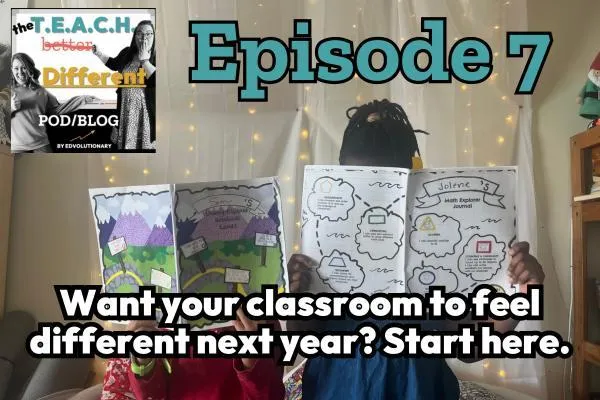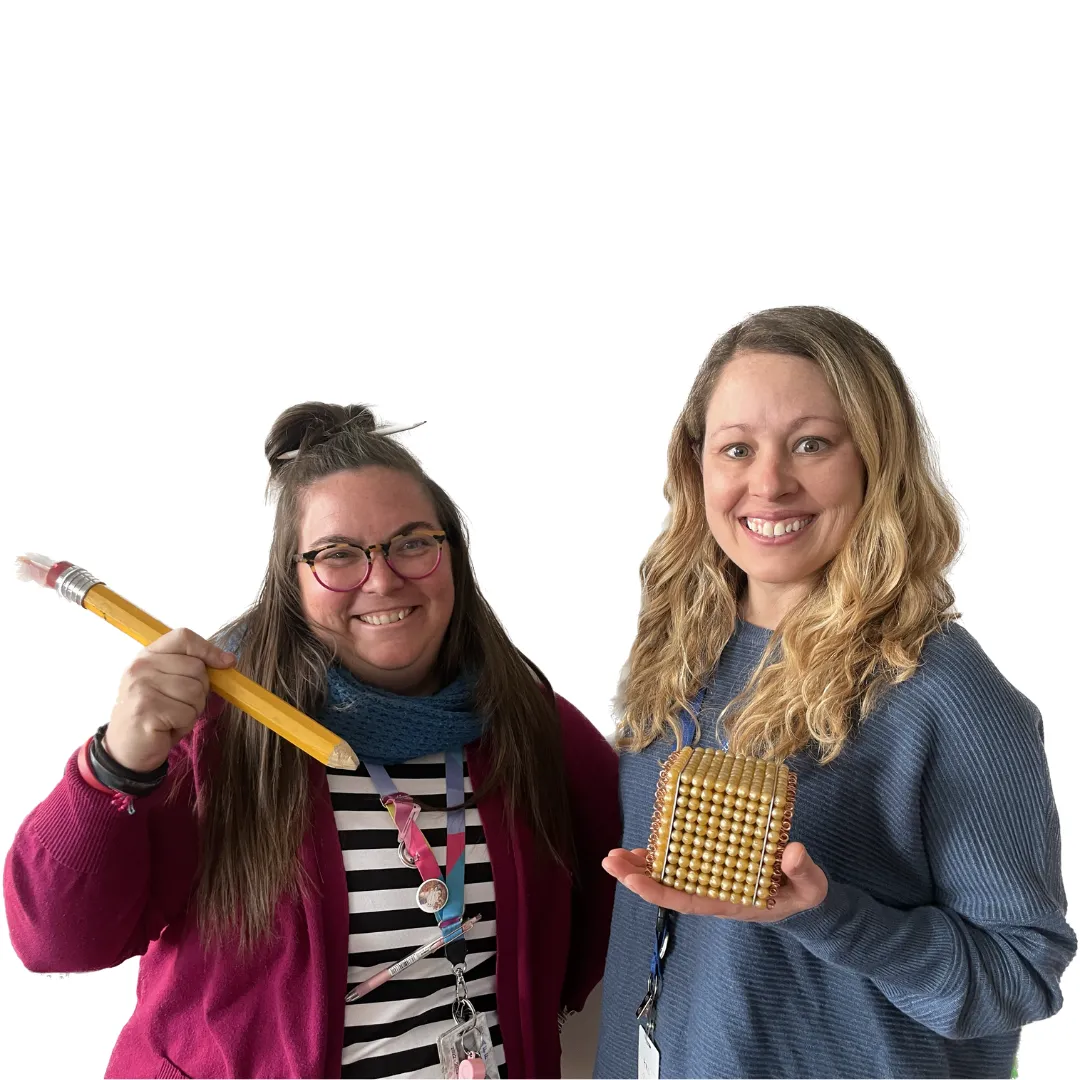The TEACH Different (not better) POD/BLOG
CREATE THE CONDITIONS THAT UNLOCK STUDENT ENGAGEMENT, ACHIEVEMENT, & WELLBEING

7: Want your classroom to feel different next year? Start here.
Listen to the episode:
This week's post is brought to you by the letter T in our T.E.A.C.H. Framework! Learn more about the Framework here.
Grab this week's companion workbook in the form at the bottom of this post under "Time for Action."
Get notified about our TEACH Different Community- opening in July!
Post/Episode Summary:
Last week we talked about how many educators feel like they are working harder and harder and teaching is not getting any easier.
If you missed that episode... go back and listen because it makes the case that the teaching roadmap we are using isn't aligned to the destination or outcomes we are hoping for.
This week we compare the map most of us are used to with a potential new map that may be able get us out of the cycle of frustration and stagnation.
Take a listen... and if we've convinced you...keep listening over the next few weeks as we start to paint a picture of how to do this!
Is your classroom like the Four Seasons?
Let’s dive right into our story. It’s actually not mine this week. It comes from a thought leader in the business world named Simon Sinek , but I think you’ll quickly see how this story applies to our world of education as well.
Watch the video here:
I want you to pay particular attention to this quote:
“Now this is the exact same human being, working at two different companies, and yet our experience of him will be profoundly different…not because of him… but because of the leadership environment in which he works.”
We all know we have students that come to us with incredible challenges. And a lot of the time it genuinely feels like those challenges are completely outside our impact or control (and for some outliers that may be entirely true… we’ve all had them).
But what if a different paradigm or map… could create the conditions that brought out a different, more accurate “Four Seasons” version of most of our students?
Which Noah do you want?
I love this story. And for the purposes of this episode I love it even more because I think it captures how different paradigms lead us to different outcomes regardless of what resources…. human or otherwise–we are working with.
Two different hotels, two different outcomes, same employee.
So which Noah would you want working in your coffee shop?
I’m guessing all of us, including the “Other Hotel” want Four Seasons Noah. And yet…the number of “Other Hotel” Noahs in our classrooms seems to be growing.
Why?
Understanding the Status Quo Paradigm
Well…which hotel reminds you more of the culture of our schools, especially with all the post-covid pressures?
Unfortunately,to borrow language from Noah, I think both students AND teachers would report feeling like they are in environments that prioritize “hitting numbers” aka results above all else, and like more time is spent catching them doing something wrong than both trusting them to do right, and giving them the support to do it.
So the answer… the culture of most of our schools is more like Other Hotel.
And sadly…this is nothing to be surprised by. The culture of many businesses, organizations and schools is like Other Hotel, because that has been our guiding paradigm for quite some time.
Underneath this paradigm is an unconscious assumption that humans would slack off or not do their best if left to our own devices, and so extrinsic stimuli provided by those in charge are needed to motivate us. It’s an old belief, likely stemming from views around innate human sinfulness that permeate our culture even if you aren’t religious.
If you can remember back to your teacher prep program, you likely learned about behaviorism– a psychological theory that views humans as largely passive creatures who are only spurred to action by extrinsic motivators– better known as rewards and punishments, and it fits perfectly with this paradigm.
Whether you buy into this paradigm or not– many of the ways we manage people– whether a boss at a business or an administrator in a school or a teacher in a classroom… are based in some part on this theory of how we get people to do things… and that nearly always involves something extrinsic.
This is how it plays out in education:
How do we get students to come to the carpet on time (positive and negative Dojo points!)
How do we get students to do their work? (good and bad grades! Loss of recess! More points! Praise! Grades!)
How do we get students to do nice things for other people? (shoutout cards! Praise! Student of the week!)
How do we get teachers to increase scores? (merit-based pay! Bad evaluations!)
Whether these rewards and punishments are valid or good or bad is something people have a lot of feelings around.
The only opinion of mine that is relevant right now is that I want to make a distinction and say logical consequences ie “you threw the dry erase markers all over the room, you need to put them away before going to recess” is totally different than the punishment of “you threw the dry erase markers all over the room, now you miss all of your recess.” In my view, logical consequences are good teaching, not behaviorism.
Getting back to my point: what I actually care about for this episode is this practical, unemotional question: do these extrinsic motivators actually give us the Four Seasons version of our students that we want?
Research on extrinsic motivators says no… and our experience should show us that while these tools may work to get compliance in the short term… it’s a deal with the devil: we end up creating learners or workers that are dependent on us to keep dishing out the extrinsic motivators to hold them accountable to what we want.
In fact, research also shows that you have to keep varying or upping the ante on extrinsic motivators to get people to do today what they did for less yesterday. So it’s no wonder things never get easier for teachers.
If we look at the best case scenario under these conditions…even if some of our students respond well to our motivators and do what we want… do we want them just showing up to collect their paycheck? Or do we want them thriving? Which is going to lead to better results in student achievement in the end?
An Alternative Paradigm
Let’s flip now to the Four Seasons.
As Simon Sinek says,
“Now this is the exact same human being, working at two different companies, and yet our experience of him will be profoundly different…not because of him… but because of the leadership environment in which he works.”
What is this leadership environment?
In contrast to other hotel, the Fours Seasons seems to operate from the belief that their employees would want to be successful, and that they will work hard and do well if they in an environment that supports them.
But what does “an environment that supports them” look like?
Like other hotel’s paradigm, there’s a great psychological theory that matches it. And it’s been around for awhile. But for some reason we don’t hear about it or learn how to put it into practical use very often.
The psychological theory I’m talking about is called Self-Determination Theory. This theory claims that humans have three innate psychological needs: mastery, autonomy and relatedness (we’ll define those in a moment). In the book Drive: The Surprising Truth About What Motivates Us, author Daniel Pink writes,
“When those needs [for autonomy, mastery and relatedness] are satisfied, we [humans} are motivated, productive, and happy.
When they’re thwarted, our motivation, productivity and happiness plummet.
Whether or not this aspect emerges in our lives depends on whether the conditions around us support it.”
Not whether we dangle the right donut.
Not whether we elicit enough fear from what will happen to someone.
Whether we unlock the best–or worst in people depends on the type of enviornment we create.
Noah isn’t an exception. The psychological need for these conditions of mastery, autonomy and relatedness is something researchers have noticed is true of humans across the world, so its the same for us and our students.
So now let’s get to the really good stuff –breaking down the ingredients to create the conditions where human beings will be motivated, productive and happy as Daniel Pink says… or as we educators might say: engaged, achieving and behaving.
The companion workbook I have for you today will include reflection questions that will help you see to what degree you are already creating these conditions in your classroom. Just know that if you’re basically at level 0 in this department, it only means things can get exponentially better in the future… and our next 3 episodes will be chalk full of actionable ideas on how.
So the first ingredient is competence. It’s often also called mastery. People have an innate desire to get better at things and when they can see themselves making progress toward mastery, it will fuel their motivation to stick with it until they’ve reached their goal.
While we may think that we must at least be meeting the condition of mastery because we care so much about achievement, you’ll see that’s not actually the case upon further inspection. Far too often our curriculum calendars are designed around meeting daily objectives rather than meeting students where they are to achieve long-term mastery. Feedback is often delayed or felt as judgement and so visible progress toward mastery is often missing as well.
Ingredient 1: Mastery
The first ingredient is mastery. People have an innate desire to get better at things and when they can see themselves making progress toward mastery, it will fuel their motivation to stick with it until they’ve reached their goal.
While we may think that we must at least be meeting the condition of mastery because we care so much about achievement, you’ll see that’s not actually the case upon further inspection. Far too often our curriculum calendars are designed around meeting daily objectives rather than meeting students where they are to achieve long-term mastery. Feedback is often delayed or felt as judgement and so visible progress toward mastery is often missing as well.
Classroom reflection questions:
1. Look at or reflect back on your student data. What percent were consistently at mastery of any given skill?
2. In your experience, how often does the curriculum-driven lesson agenda prevent students from mastering something before moving on to the next thing?
Never
Sometimes
Often
3. What percentage of work students produce gives them an idea on how they are doing toward mastering that knowledge or skill?
Ingredient 2: Autonomy
The second ingredient for these conditions is autonomy. Autonomy and independence are often confused but it is important to know the difference. Independence, which we often talk about a lot in schools as in “we want our learners to be independent” involves being able to do something without support from others. Autonomy, on the other hand, involves feeling like you are the one in control of your own life and choices. Students who have experience with autonomy through making decisions learn how to be independent learners who don’t need others to tell them what to do. Those who have no ability to make choices end up abdicating their will and becoming dependent because they are used to others making decisions for them. Quick soap box: We often blame students for their dependence but in fact… it is the underlying structure of how school operates that creates this in them.
Classroom reflection question:
How often in the school day do students get to make meaningful choices about what they do or how they do it?
Ingredient 3: Relatedness
The last ingredient is relatedness. Humans need to feel a sense of belonging and connection with others in our environment to feel safe enough to focus on things beyond our mere psychological survival. It’s not teacher’s faults, but think just how much our urgent, primarily whole-group instructional day gets in the way of building authentic, non-transactional relationships with students or giving them time to build relationships with each other.
Classroom reflection questions:
1. Where do you find time to build the quality relationships in your day with students?
2. How many of your students have you built strong, trusting relationships with?
3. When do students have time to get to know each other and build quality relationships?
Time for Action
All these questions and more you can reflect on in the free companion guide below. And if the questions in this exercise felt illuminating in a not great way– I think it’s cause for celebration. It means there is something new you can do to change the nature of what next school year will look like, and the next three posts are going to dive deeper into these ingredients that will help you make it happen.
Download the companion workbook here!
Also…If you want to join a community further diving into these topics and others of our TEACH Framework, don’t forget to sign up to be notified when our TEACH Different Collective opens later this summer! To read about our initial vision, give your input and/or join the list to get notified when this community opens, go to edvolutionary.com/collective. You can also add your name to the notification list using the form below!
All links from this post/episode
Thank you for being on the journey with us as we build out this content
What do we mean by TEACH Different (not better?)


